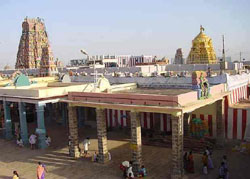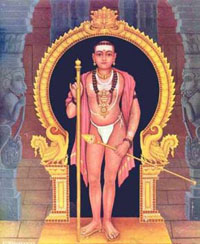
The hill temple of Lord Muruga as Sri Dandayuthapani in Palani near Madurai is one of the most popular of Tamil Nadu fanes, dates from a remote past. It stands on a hill that is an offshoot of the Western Ghats, and there are some other hills nearby. From the temple, which stands at the summit about 150 metres high, there is a beautiful panorama of forests to admire.
At the foot of the hill there is an even more ancient temple, also dedicated to Lord Muruga and is called the "Tiruavinnakudi Temple", it is the third of the "arupadai veedus", or the Six Abodes of Lord Muruga, as mentioned in a Tamil poem of the first century of the Christian era, "Tirumurugarruppadai". The other five are Tirupparankundram, Tiruchendur, Swamimalai, Tiruttani and Pazhamuthircholai (on Azhagarkoil hills).
The origin of the temple
Tradition tells the temple's origin. Once Agastya wished to take away Shivagiri, the hill on which the temple stands, and Sakthigiri in its vicinity, to where he was living farther in the south. He directed a disciple of his, Idumban, to carry them on his shoulders, one at each end, slung to a pole in the form called "Kavadi".

At this stage, Lord Shiva on Kailasa, had offered a pomegranate as a prize to whichever of His sons, Lord Ganesh and Lord Muruga, could go round the world quicker. Lord Muruga, astride His vehicle, the peacock, set off at a great pace. But Lord Ganesh merely walked around His parents. He said that, as they were the Universe, He was walking around them. The claim was conceded and the prize was awarded to Him. On hearing this Lord Muruga was frustrated and left Kailasa for the south. His parents attempted to dissuade Him, saying "Pazham Nee" which means in Tamil, "Thou art thyself the fruit of all wisdom and knowledge". But He was not appeased and went to Tiruavinankudi. Later He moved into the temple at the top of the hill.
Meanwhile, Idumban set down his "Kavadi" near Palani in order to take rest. When, after some time he attempted to bear it on his shoulders again, he found that he could not. A boy carrying a baton wandered along. An altercation ensued between this boy, who was Lord Muruga, and Idumban. In this Idumban was killed. But the Lord restored him to life. At his request He ordained that those who carry "Kavadis" to His temples in fulfilment of vows should be blessed.
The tradition accounts for the presence of the Lord in the temple as Boy baton in hand, for the popular name of the hill as "Palani" and for the practice of pilgrims carrying "Kavadis". This practice obtains not only in Palani but also in the other temples of Lord Muruga. There is a shrine to Idumban on the hill.
About the temple
The temple has seven inscriptions. None has a bearing on its origin. But tradition ascribes it to a Siddha named Bogar, believed to be a junior contemporary of Agastya (Siddhas had supernatural powers and performed miracles). Cheraman Perumal, the royal Kerala saint is believed to have constructed the Sanctum and the Ardhamandapa. If this tradition is correct, the structural beginnings of the temple should be dated to the eighth century. In two places in the temple there are sculptures of a royal personality. In succeeding times the temple was expanded by the Nayaks of Madurai and by the local chiefs. The Nagarattars performed many renovations in recent times.
Rock hewn steps used to lead from the foot of the hill to the top, but now there are 697 stone steps. Since 1966 a haulage winch transports the pilgrims. On either side of the pathway there are shrines and Mandapas at frequent intervals. At the entrance to the temple there is an extensive quadrangle. The temple is set at an spacious Prakara, which contains many structures. Two of the Mandapas, the Navaranga and the Paravel Mandapas, are of great beauty, with many attractive pillars.
Interesting Features
The image of the Lord is made of nine kinds of medicinal minerals. What is remarkable is that the millions of Abishekas, or oblations poured on the image, down the centuries have had no effect on it. On the contrary, the Abisheka materials gain in medicinal properties from contact with the image and are prized by physicians. In particular the sandal paste, which is left on the image overnight, is a wonder drug. Every bit of it is used. In the southwestern corridor of the temple there is a shrine to Bogar, whom the pilgrim is enjoined to worship.
Around the hill runs a sacred path, about a mile long. Mandapas stand along side, with large lithic figures of the peacock, the Lord's mount. Perambulating the hill is considered a holy act. Many pilgrims have their heads tonsured.
Festivals Celebrated
Palani and festivals are synonymous. The most important festival is "Panguni Utharam" in March - April on the day Utharam Star (Nakshatra) is ascendent. This 10-day event at the Tiruavinnakudi Temple, at the foot of the hill occurs in the off-season and so agriculturists and other rural folk participate in it and give offerings of paddy to the temple. About five lakh people attend the festival.
Some of the monthly Karthigais draw a crowd of one lakh. The Karthigai Deepam and Vaikasi Visakam get two lakhs of persons each. The same may be said of Skanda Sasthi. Three lakhs persons attend the Thaipusam festival. |